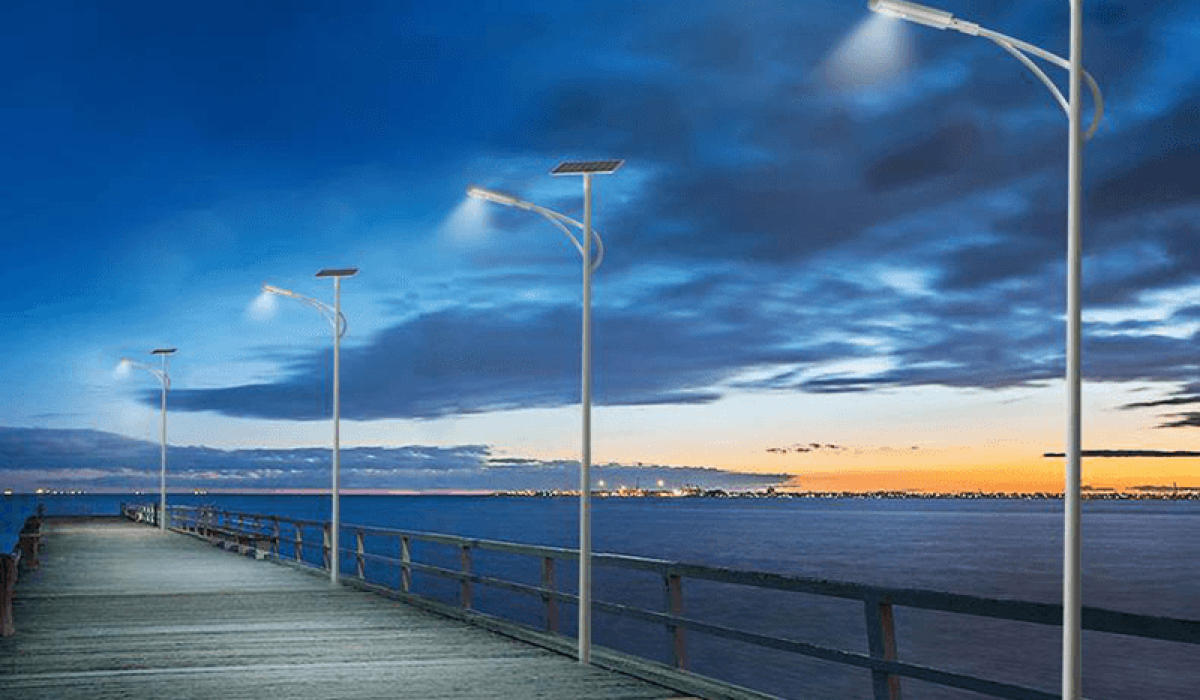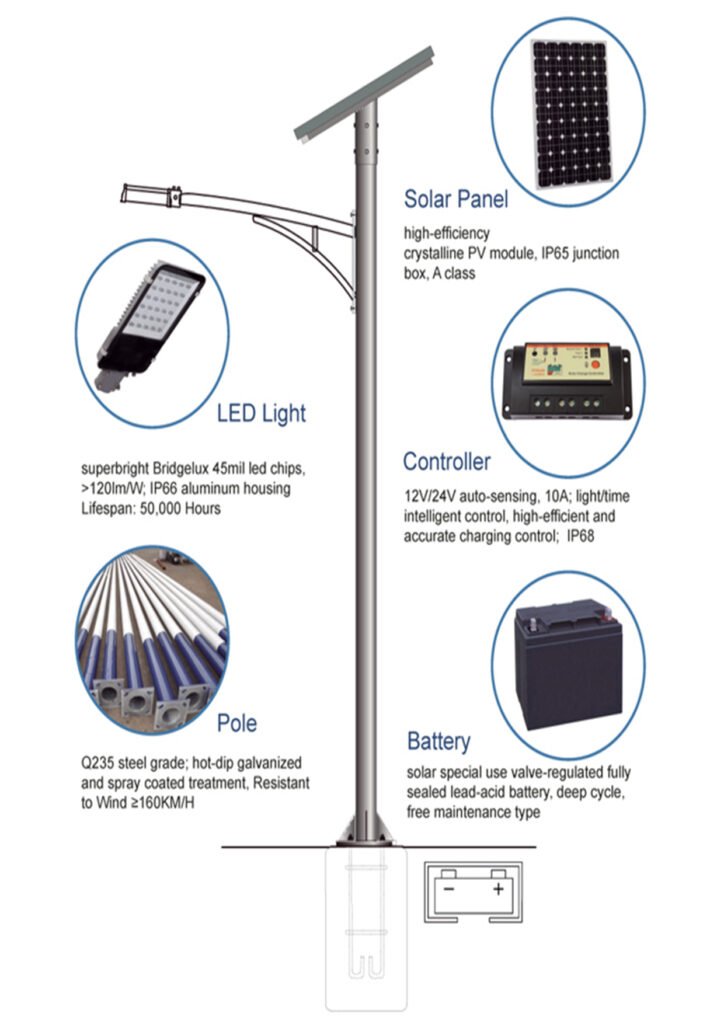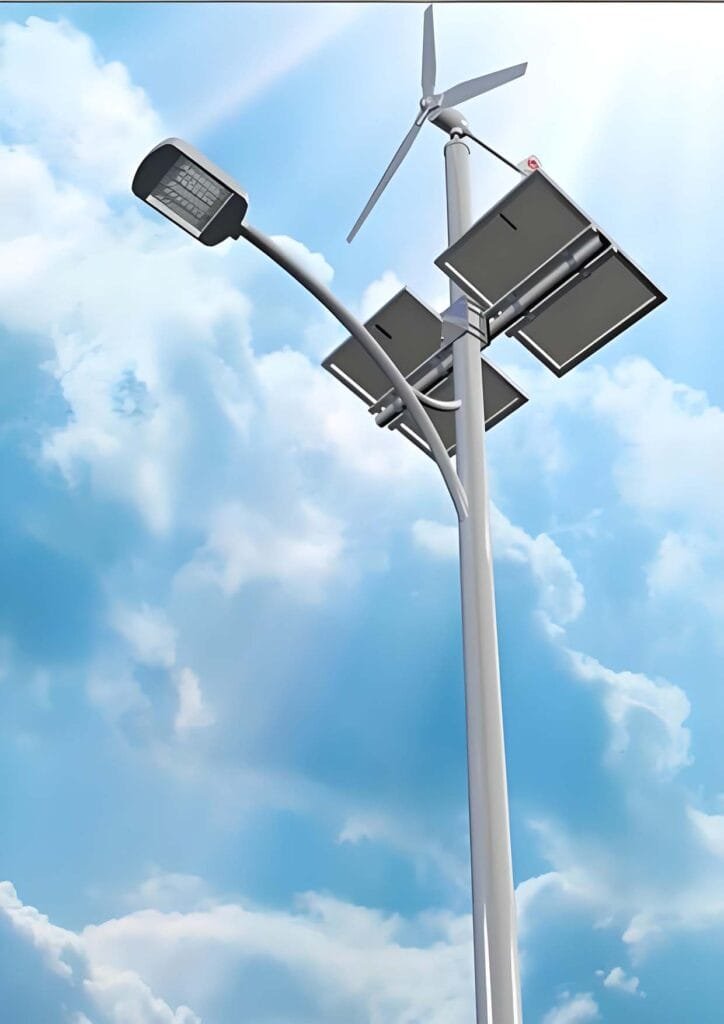Introduction – Why Solar Street Lights Matter in 2025
In many countries today, millions of people still live without stable electricity. Cities face blackouts, villages remain dark after sunset, and governments need quick and visible solutions. Street lighting is not only about light, it is about safety, community life, night economy and trust from citizens.
Solar street light becomes one of the fastest ways to bring result. No cable trenching, no monthly power bill, less maintenance. In Africa, Middle East and Asia, many municipalities and EPC contractors now choose solar street lights for highways, rural roads, ports, industrial parks and community projects.
Sunlurio has been working with different governments and EPC contractors. For example:
- 500 sets in Burkina Faso, 7m pole, 60W LED, improved safety in rural road.
- 7000 sets in Togo, part of electrification program, supported by Ministry of Energy.
- 2000 sets in Mauritania, for desert road and industrial zone.
- 3500 sets in Nigeria, urban and industrial park, running over one year.
These projects prove that solar street lights are not only technology, but also a strong tool for governments to improve public service with limited budget.
What Is a Solar Street Light?
A solar street light is a standalone outdoor lighting system that works with solar panel, battery, controller and LED lamp. During the day, solar panel converts sunlight into electricity and stores inside the battery. At night, the controller will release the power to LED lamp, and give stable lighting for 12–14 hours.
No need for grid connection, no need to pay electricity bill. Good for remote areas, villages, coastal towns, or anywhere the cable cost is too high.
Main Components of a Solar Street Light
LED Light Source
Modern solar street lights use high efficiency LED chips. A normal LED is 150 lm/W, but Sunlurio products use 230 lm/W LED. That means, same brightness but less power consumption. For government projects, this means smaller panel, smaller battery, lower cost.
Battery
Battery is the “fuel tank” of solar light. Old projects use lead-acid battery, only 300–500 cycles, easy to die in 2 years. Now good projects use LiFePO₄ battery with 6000+ cycles. This is very important for tenders, because government need 8–10 years lifespan. In Burkina Faso project, after one year running, capacity still stable over 95%.
Controller
Controller is the “brain” of solar street light. It decides charging, discharging, timing, dimming. Modern controllers use MPPT technology, improve efficiency 20–30%. Also can connect with remote IoT system for smart city.
Pole and Structure
Pole is not only metal. For coastal or desert area, corrosion is the killer. Sunlurio provides hot-dip galvanized pole, with ISO 1461 and ISO 12944 coating, salt spray test ≥ 720h. In Mauritania desert project, after sandstorm season, poles still in good condition.
Types of Solar Street Lights
All-in-One Solar Street Light
- Design: Solar panel, LED, battery, controller in one body.
- Advantage: Easy to install (15–20 minutes per set), less cable, good for villages.
- Limitation: Battery size limited, not suitable for 9–10m poles or highways.
- Example: Burkina Faso 500 sets project finished in 12 days.
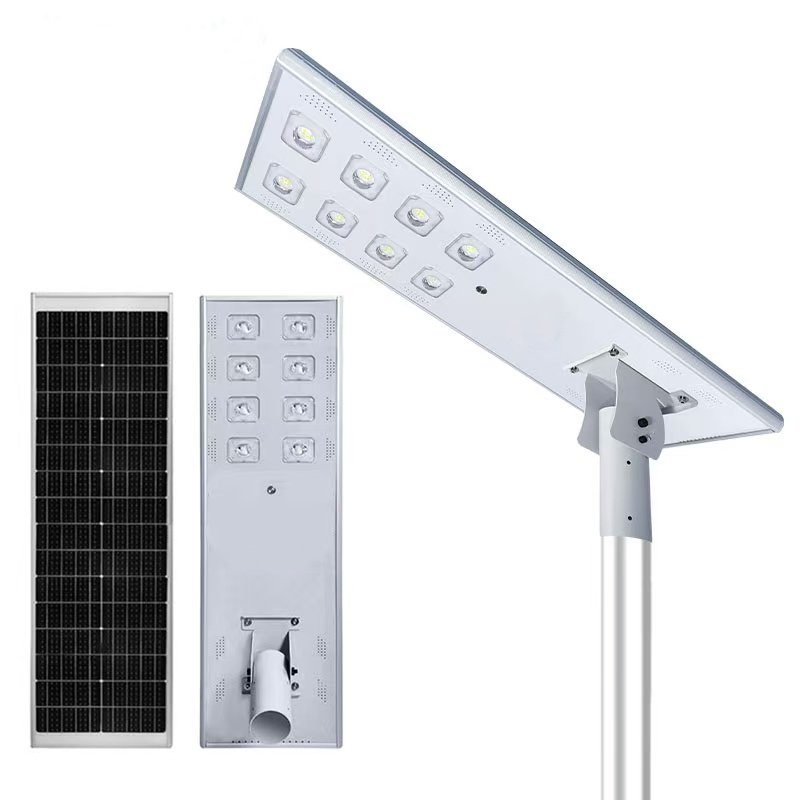
Split-Type Solar Street Light
- Design: Solar panel separate from lamp body, bigger battery box.
- Advantage: Higher capacity, can use 80–120W LED, suitable for highways.
- Limitation: More installation work, need good waterproofing.
- Example: Nigeria 3500 sets project used split type in highway.
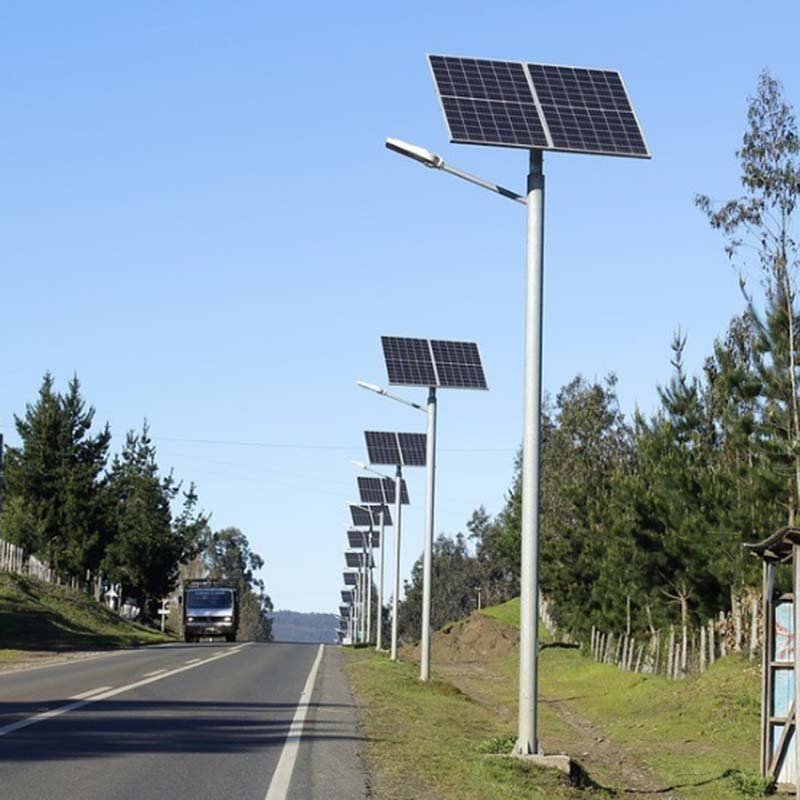
Smart IoT-Enabled Solar Street Light
- Design: With wireless controller, cloud platform, real-time monitoring.
- Advantage: City can check battery, lamp status, failure alarm.
- Limitation: Higher cost, need 4G or LoRa network.
- Example: Togo 7000 sets program, some lights with IoT control for Ministry of Energy.
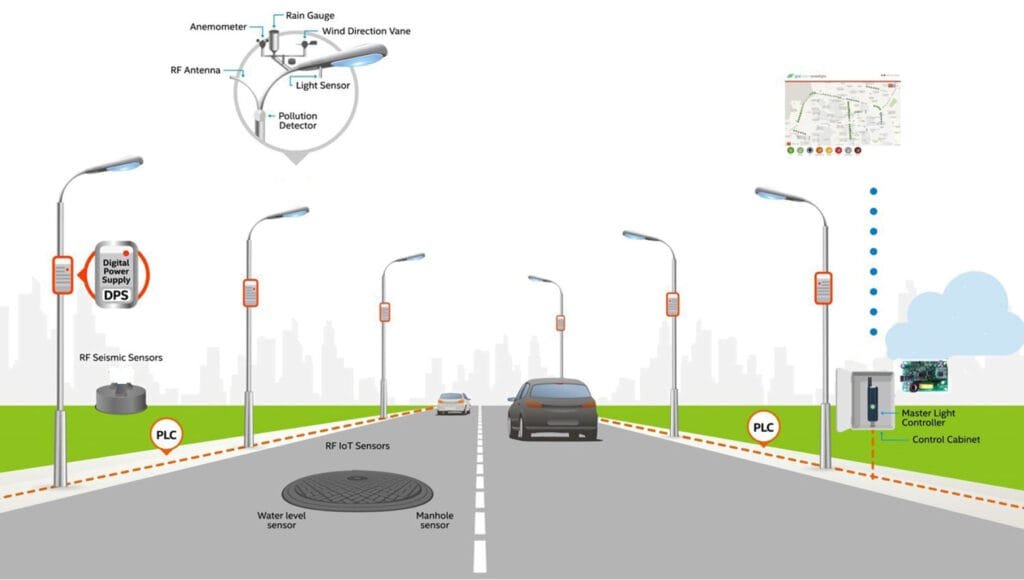
Technical Specifications to Consider
Power & Brightness
- Real brightness = Watt × lm/W efficiency.
- 60W × 230 lm/W = 13,800 lumen.
- Fake “200W” lamp at 100 lm/W = only 20,000 lumen but cost bigger battery.
Battery Life & Cycles
- Lead-acid: 500 cycles → 1–2 years.
- LiFePO₄: 6000 cycles → 8–10 years.
Efficiency (lm/W)
- Old design: 120–150 lm/W.
- New: 220–230 lm/W → 20–30% cost saving in 10 years.
Pole & Anti-Corrosion
- Standard: EN 40, ISO 1461, ISO 12944.
- Salt spray test ≥ 720h.
Certifications & Compliance
- IEC 60529 (IP66), IEC 62262 (IK08/IK10).
- UN38.3 for lithium battery transport.
- EU Battery Regulation 2023/1542.
Applications of Solar Street Lights
Urban Roads & Highways
9–10m poles, 80–120W LED. In Nigeria highway, 1800 units gave average 16 lux on road.
Rural Electrification
6–7m poles, 40–60W LED. In Burkina Faso, shops opened until 10pm, local business improved.
Coastal Ports & Harbors
Hot-dip galvanized poles, IP66, salt spray ≥720h. Mauritania project still stable after sea wind.
Industrial Parks & Security
Lights reduce accident and theft. In Nigeria industrial zone, incidents reduced by 40%.
Smart Cities
IoT system with dashboard for monitoring. Togo government check performance online.
Case Studies
- Burkina Faso: 500 sets, accident reduced 45%, ROI 3 years.
- Togo: 7000 sets, coverage 95%, benefit over 500,000 citizens.
- Mauritania: 2000 sets, desert & coast, 98% running stable after 12 months.
- Nigeria: 3500 sets, city + industrial, USD 1.2 million TCO saving in 10 years.
Government Tender & Procurement Guide
Key Requirements
- LED ≥200 lm/W, battery ≥6000 cycles, IP66, IK08.
- UN38.3, IEC, CE, RoHS, MSDS.
RFQ / RFP Templates
- Specification table (watt, lumen, pole).
- Compliance checklist.
- Warranty plan (≥5 years).
Pitfalls to Avoid
- Fake wattage, wrong battery type, missing compliance file.
Buyer Checklist
- Verify battery test report.
- Confirm lumen efficiency.
- Check certification number.
- Ask for project reference.
- Ensure packaging test report.
Financing Options for Large Projects
EPC & PPP Models
- EPC contractor builds, government pays by milestone.
- PPP allows private partner to operate and recover cost by service fee.
Sinosure-Backed Financing
- Chinese export credit insurance, reduce risk for government borrower.
- Example: Many African projects financed with Sinosure + local bank.
Development Banks & Donors
- BOAD, AFD, AfDB, World Bank.
- Often require compliance with EU Battery Regulation, sustainability reports.
Total Cost of Ownership (TCO) Analysis
- Initial cost: Solar light higher than grid light.
- Operation cost: No electricity bill, no trenching.
- 10-year comparison:
- Grid light: $100,000 installation + $15,000/year electricity = $250,000 total.
- Solar light: $150,000 installation, almost zero operation = $150,000 total.
- Saving: ~40% in 10 years.
- In Nigeria project, estimated saving = USD 1.2 million over 10 years.
How to Choose the Right Supplier
- Must provide real certification (IEC, UN38.3).
- Show past project data with photos.
- Offer 5–10 years warranty in writing.
- Have financing solution (EPC, PPP, Sinosure).
- Provide after-sales support & spare parts.
FAQs
Q: How long does a solar street light last?
A: With LiFePO₄ battery (6000 cycles), 8–10 years lifespan.
Q: What is the best battery?
A: LiFePO₄, much better than lead-acid.
Q: How many hours can it work at night?
A: Standard design ≥12 hours per night, 3 nights backup.
Q: What certifications are needed for tenders?
A: IEC 60529, IEC 62262, UN38.3, CE, RoHS, MSDS.
Q: How many lights per km of road?
A: Normally 25–30m spacing, 35–40 lights per km for two-lane road.
Conclusion & Call to Action
Solar street lights are no longer just alternative technology. They are proven solution for cities, villages, highways and industrial zones. With high efficiency LED (230 lm/W), long-life battery (6000 cycles), and strong compliance (IEC, UN38.3, EU Battery Passport), governments and EPCs can save 20–30% TCO in 10 years and deliver visible result to citizens.
Sunlurio has already supplied 500 sets in Burkina Faso, 7000 sets in Togo, 2000 sets in Mauritania, 3500 sets in Nigeria. All projects show clear impact on safety, economy and community life.
👉 If you are preparing a government tender or EPC project, contact Sunlurio today to get:
- Free Tender Package PDF (specs + certifications).
- Case study details with ROI data.
- Financing support (EPC, PPP, Sinosure).
Request a Quote Now – Build safer, brighter, and smarter communities with solar street lights.

